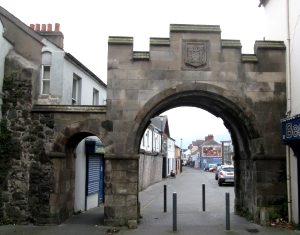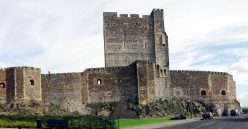 Jim talked to us about the history of Carrickfergus, his theme being “Royal Visits”. We were informed that the town of Carrickfergus has been in existence since medieval times. The earliest known name for the area was Dun-so-barky, meaning “strong rock or hill”. It gained the current name under tragic circumstances. In the sixth century, Fergus Mor, the son of Eric of Armoy, left Ulster to found a kingdom in Scotland but was drowned on his return. The area was thereafter called Carraig Fhearghus, meaning “rock of Fergus”.
Jim talked to us about the history of Carrickfergus, his theme being “Royal Visits”. We were informed that the town of Carrickfergus has been in existence since medieval times. The earliest known name for the area was Dun-so-barky, meaning “strong rock or hill”. It gained the current name under tragic circumstances. In the sixth century, Fergus Mor, the son of Eric of Armoy, left Ulster to found a kingdom in Scotland but was drowned on his return. The area was thereafter called Carraig Fhearghus, meaning “rock of Fergus”.
In 1183, the Anglo-Norman knight John de Courcy invaded Ulster and established his castle on a volcanic dyke at Carrickfergus. Between 1203 and 1205, De Courcy was ousted from Ulster by another Anglo-Norman knight, Hugh De Lacy. De Lacy finished the construction of the castle, building the gatehouse, drum towers and outer ward. Hugh was a bit of a rogue.”
In 1210 King John arrived at Carrickfergus, expelled De Lacy and took the castle into royal authority. Some say that this took no effort at all since Hugh, knowing full well that he deserved it, fled to France.
 Carrickfergus found itself entangled at the very heart of national and European politics when, in 1688, the town and castle were held by the garrison troops for James II, despite local overwhelming sympathy for the Williamite cause. In 1689 Frederick Duke of Schomberg landed with Williamite forces at Groomsport, Co Down. The siege of Carrickfergus began on August 20 with heavy mortar bombings, causing a breech in the town wall near north gate. The defenders drove cattle into this breech and shot them to block it up. Never-the-less, The surrender of the garrison troops took place about seven days later. This picture is of the North Gate as it stands today.
Carrickfergus found itself entangled at the very heart of national and European politics when, in 1688, the town and castle were held by the garrison troops for James II, despite local overwhelming sympathy for the Williamite cause. In 1689 Frederick Duke of Schomberg landed with Williamite forces at Groomsport, Co Down. The siege of Carrickfergus began on August 20 with heavy mortar bombings, causing a breech in the town wall near north gate. The defenders drove cattle into this breech and shot them to block it up. Never-the-less, The surrender of the garrison troops took place about seven days later. This picture is of the North Gate as it stands today.
June 14, 1690, King William of Orange stepped ashore at Carrickfergus destined for the Battle of the Boyne, where he defeated his father-in-law James II and claimed the English crown for himself.
Jim was at pains to point out that William was supported by the Vatican for purely selfish reasons of their own.
1885 say a visit from Queen Victoria’s son Albert Edward and his wife Alexandra. The piers of the harbour are named after them.
Bringing the story up to date, Carrickfergus had a visit in 1961 of our current Queen Elizabeth II followed in 1987 by Prince Andrew and in 1988 by Princess Anne.
 As a token of our thanks for his visit, Jim was presented with a Carrickfergus Men’s Shed Mug (with Easter Eggs) and Alan offered him the choice from his selection af hand turned wooden pens.
As a token of our thanks for his visit, Jim was presented with a Carrickfergus Men’s Shed Mug (with Easter Eggs) and Alan offered him the choice from his selection af hand turned wooden pens.
